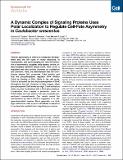| dc.contributor.author | Tsokos, Christos G. | |
| dc.contributor.author | Perchuk, Barrett | |
| dc.contributor.author | Laub, Michael T. | |
| dc.contributor.author | Tsokos, Christos G. | |
| dc.contributor.author | Laub, Michael T | |
| dc.date.accessioned | 2014-12-03T19:38:48Z | |
| dc.date.available | 2014-12-03T19:38:48Z | |
| dc.date.issued | 2011-03 | |
| dc.date.submitted | 2011-01 | |
| dc.identifier.issn | 15345807 | |
| dc.identifier.issn | 1878-1551 | |
| dc.identifier.uri | http://hdl.handle.net/1721.1/92029 | |
| dc.description.abstract | Cellular asymmetry is critical to metazoan development and the life cycle of many microbes. In Caulobacter, cell cycle progression and the formation of asymmetric daughter cells depend on the polarly-localized histidine kinase CckA. How CckA is regulated and why activity depends on localization are unknown. Here, we demonstrate that the unorthodox kinase DivL promotes CckA activity and that the phosphorylated regulator DivK inhibits CckA by binding to DivL. Early in the cell cycle, CckA is activated by the dephosphorylation of DivK throughout the cell. However, in later stages, when phosphorylated DivK levels are high, CckA activation relies on polar localization with a DivK phosphatase. Localization thus creates a protected zone for CckA within the cell, without the use of membrane-enclosed compartments. Our results reveal the mechanisms by which CckA is regulated in a cell-type-dependent manner. More generally, our findings reveal how cells exploit subcellular localization to orchestrate sophisticated regulatory processes. | en_US |
| dc.description.sponsorship | National Institutes of Health (U.S.) (Grant 5R01GM082899) | en_US |
| dc.description.sponsorship | Howard Hughes Medical Institute. Early Career Scientist Program | en_US |
| dc.language.iso | en_US | |
| dc.publisher | Elsevier | en_US |
| dc.relation.isversionof | http://dx.doi.org/10.1016/j.devcel.2011.01.007 | en_US |
| dc.rights | Article is made available in accordance with the publisher's policy and may be subject to US copyright law. Please refer to the publisher's site for terms of use. | en_US |
| dc.source | Elsevier | en_US |
| dc.title | A Dynamic Complex of Signaling Proteins Uses Polar Localization to Regulate Cell-Fate Asymmetry in Caulobacter crescentus | en_US |
| dc.type | Article | en_US |
| dc.identifier.citation | Tsokos, Christos G., Barrett S. Perchuk, and Michael T. Laub. “A Dynamic Complex of Signaling Proteins Uses Polar Localization to Regulate Cell-Fate Asymmetry in Caulobacter Crescentus.” Developmental Cell 20, no. 3 (March 2011): 329–341. © 2011 Elsevier Inc. | en_US |
| dc.contributor.department | Massachusetts Institute of Technology. Department of Biology | en_US |
| dc.contributor.mitauthor | Perchuk, Barrett | en_US |
| dc.contributor.mitauthor | Laub, Michael T. | en_US |
| dc.contributor.mitauthor | Tsokos, Christos G. | en_US |
| dc.relation.journal | Developmental Cell | en_US |
| dc.eprint.version | Final published version | en_US |
| dc.type.uri | http://purl.org/eprint/type/JournalArticle | en_US |
| eprint.status | http://purl.org/eprint/status/PeerReviewed | en_US |
| dspace.orderedauthors | Tsokos, Christos G.; Perchuk, Barrett S.; Laub, Michael T. | en_US |
| dc.identifier.orcid | https://orcid.org/0000-0002-8288-7607 | |
| mit.license | PUBLISHER_POLICY | en_US |
| mit.metadata.status | Complete | |
